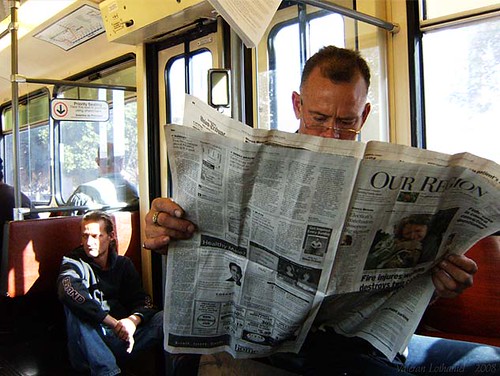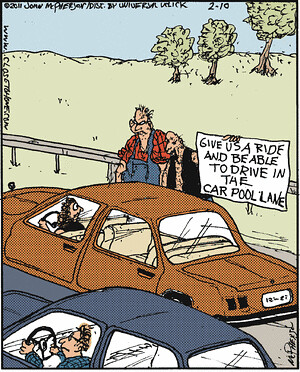Close to Home comic, 2/10/2011.
For some reason, many of us are mathematically challenged. This is often referred to as innumeracy, which means being unfamiliar with mathematical concepts and methods.
One math concept that seems to elude most of us is the idea of capacity. Roads have a finite capacity. One lane of road mile on a freeway has a capacity of 1,600 to 2,200/cars/hour depending on speed and conditions. This presumes no entrances onto the road, unlike "arterial," which have many entrances usually, and therefore reduced capacity compared to limited access highways.
The concept of HOV--high occupancy vehicles--lanes looks at capacity not just in terms of vehicles, which is "finite" (see previous paragraph) but in terms of the throughput of people. Most vehicle trips contain only the driver and no passengers. By providing incentives--faster trips--for vehicles with a greater number of occupants, more people move through the road system, and presumably this comes with a reduction in the total number of vehicles in the system during rush periods, because people are sharing vehicles.
The concept of High Occupancy Toll lanes doesn't focus on passenger throughput, but the value of time to drivers, and monetizing that time (opportunity costs) through tolls, preferably variable tolls that charge higher rates according to demand.
Except in that additional lanes might be built, no new capacity for vehicles is added.
The issue becomes which policy choice:
-- moving more people vs.
-- making revenue without moving more people
is preferred.
Arlington County focuses on people throughput over vehicle throughput, and their
Master Transportation Plan and each Element of the plan in turn prioritizes this goal and policy objective. They believe, rightly, that providing opportunities for individuals to pay a toll for premium service comes at the cost of people throughput and shouldn't be supported.
From the
MTP Goals and Policies Element:
Goal 2: Move More People Without More Traffic
Provide more travel choices and reduce the relative proportion of single-occupant-vehicle (SOV) through Transportation Demand Management (TDM), telecommuting, and travel shifts to other modes including transit, carpooling, walking, and bicycling.
Strategies
1. Implement land use policies such as transit-oriented and mixed-use development that result in better access and use of the transportation system.
2. Focus on minimizing person delay across modes rather than focusing exclusively on minimizing vehicle delay.
3. Encourage the use of environmentally sustainable modes, including bicycling, walking, transit, carpooling, and telecommuting.
Everything about Arlington's opposition to HOT lanes derives from their transportation plan.
In short, Arlington County has planning and mathematically based reasoning behind their transportation policy.
The
Washington Post, in the editorial "
Arlington County wins a battle over HOT lanes but may lose a war," doesn't have math on its side. Merely, they say more people live farther out and therefore their desires to reduce their time spent commuting should be accommodated. From the article:
Nearly half of all of Virginia's population growth in the past decade has been in the jurisdictions between Fredericksburg and the Beltway. Hundreds of thousands of commuters who ply that route are desperate for a faster commute in and out of the District; those wishes have now been thwarted. In the process, though, Arlington may well have undercut its own economic interests by making it increasingly difficult for the county's own employers to attract workers willing to brave traffic inside the Beltway.The issue is should sprawl be accommodated, or should it be discouraged?
Arlington votes for discouragement as sprawl is economically unsustainable. The
Post should recognize that the farther people live outside of the core of the region, the less they care about the core of the region, including whether or not they believe it is worth subscribing to the
Washington Post, versus their local newspaper such as the
Fredericksburg Free Lance Star.
For better or for worse (unless the
Post, like the
Atlanta Journal-Constitution, moves out of the center city to the suburbs) the
Post ought to recognize that it's destiny lies with support of urbanism and intensification in the core, not sprawl.
Witold Rybczynski, in
Makeshift Metropolis, makes a very interesting point about newspapers, that evening newspapers went out of business along with the streetcars, because people would read a newspaper on the way home from work while riding the streetcar, but people driving home listen to the radio instead. Sure, automobile dealers buy ads in the paper, but transit riders read the newspaper on transit...
 A man reading the newspaper on the San Diego Trolley. Note that he is reading the local news section. Flickr photo by Valeran Lothaniel.
A man reading the newspaper on the San Diego Trolley. Note that he is reading the local news section. Flickr photo by Valeran Lothaniel.Labels: media and communications, transportation planning





0 Comments:
Post a Comment
<< Home